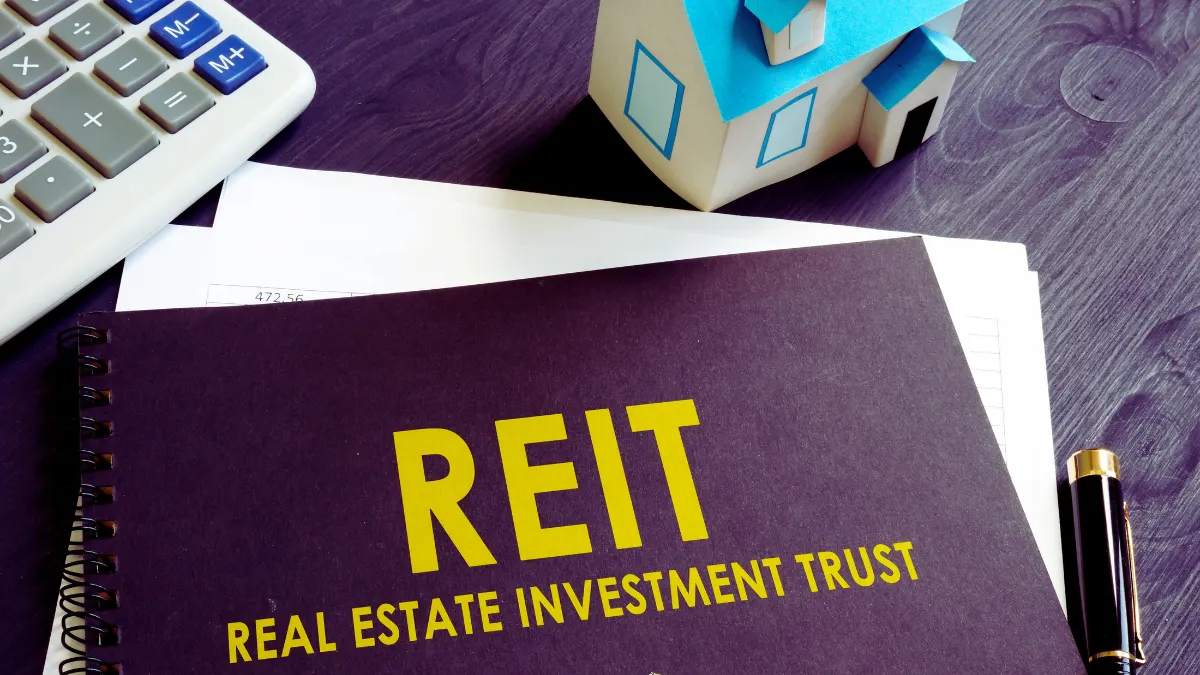Tired of chasing tenants for rent payments at 2 AM? Sick of emergency repair calls ruining your weekends? Traditional rental properties promise passive income but deliver active headaches instead.
Every month brings the same stress: late payments, property damage, vacancy periods, and eating your profits. You wanted financial freedom, not a second job managing problem tenants and endless maintenance issues.
What if you could earn consistent monthly real estate income without ever dealing with a single tenant? These five investment strategies generate steady cash flow while professionals handle everything else.
No midnight phone calls, no eviction notices, no repair bills. Just monthly payments are deposited directly into your account.
1. Publicly Traded REITs: Liquid, Transparent, and Monthly Dividends

Real Estate Investment Trusts represent the most accessible path to monthly real estate income. These companies own or finance income-producing properties across various sectors, including retail, healthcare, industrial, and residential.
Most REITs distribute dividends quarterly, though select options like Realty Income (O) and STAG Industrial provide monthly payments.
Public REITs trade on major exchanges like stocks, providing instant liquidity that private alternatives cannot match.
Legal requirements mandate the distribution of at least 90% of taxable income to shareholders, creating consistent income streams with professional management handling all tenant relations and property maintenance.
How do They Work?

REITs function as pass-through entities that collect rent from tenants and distribute proceeds to shareholders. Management teams handle property acquisition, maintenance, lease negotiations, and tenant relations.
Investors purchase shares representing fractional ownership in entire portfolios rather than individual properties. Dividend payments stem from rental income minus operating expenses, creating predictable cash flow streams.
Companies must maintain specific asset allocation requirements, keeping at least 75% of assets in real estate. This structure ensures focus remains on property income generation rather than speculative ventures.
Professional management expertise reduces individual investor workload while providing access to institutional-grade properties typically unavailable to smaller investors.
How to Invest?

Investment requires opening a standard brokerage account through platforms like Fidelity, Charles Schwab, or E*TRADE. Research focuses on dividend yield, funds from operations (FFO), and sector exposure.
Monthly dividend REITs include Realty Income for retail properties, Medical Properties Trust for healthcare facilities, and STAG Industrial for warehouse assets.
Portfolio diversification across property types reduces concentration risk. Many investors combine multiple REITs or purchase REIT-focused exchange-traded funds for broader exposure.
Dividend reinvestment plans allow automatic reinvestment of distributions, compounding returns over time without additional transaction costs.
Investment Steps

- Open a brokerage account with a major financial institution
- Research REIT fundamentals, including FFO, dividend coverage ratios, and debt levels
- Select individual REITs or diversified REIT ETFs based on income goals
- Purchase shares through an online trading platform during market hours
- Monitor quarterly earnings reports and dividend announcements
- Consider automatic dividend reinvestment for compounding growth
- Review portfolio allocation quarterly to maintain diversification
Pros and Cons

Pros:
- Low minimum investment starting at a single share price
- High liquidity with instant buying and selling capability
- Professional management handles all tenant and property issues
- Portfolio diversification minimizes single property exposure.
Cons:
- Dividends are taxed as ordinary income at higher rates
- Share prices fluctuate with stock market sentiment
2. Private Real Estate Syndications: Direct Ownership in Specific Properties

Syndications pool investor capital to purchase individual properties under professional management.
General Partners identify opportunities, conduct due diligence, and manage operations, while Limited Partners contribute capital for passive ownership stakes.
This structure provides direct property ownership without daily management responsibilities.
Investment minimums range from $25,000 to $100,000, restricting access to accredited investors with substantial capital.
Holding periods span five to ten years, offering limited liquidity but potentially higher returns than public alternatives with significant tax advantages through depreciation deductions.
How do They Work?

Syndication sponsors locate properties with strong income potential and present opportunities to investor groups.
Legal structures typically use Limited Liability Companies or Limited Partnerships, defining investor rights and profit distributions.
Private Placement Memoranda outline investment terms, projected returns, and risk factors requiring careful review before investment decisions.
Capital calls occur during property acquisition, with investors funding their committed amounts.
Monthly or quarterly distributions begin after property stabilization, continuing throughout the holding period.
Sponsors manage tenant relations, property maintenance, and capital improvements while providing regular performance updates to investors.
How to Invest?

Accredited investor verification represents the first requirement, confirming annual income exceeding $200,000 or net worth above $1 million.
Platforms like EquityMultiple, CrowdStreet, and RealCrowd connect investors with syndication opportunities.
Due diligence includes sponsor track record evaluation, market analysis, and property-specific underwriting review.
Investment commitment occurs through subscription agreements and capital contribution schedules. Legal documentation review should include attorney consultation for complex structures.
Ongoing monitoring involves quarterly reports, property updates, and market condition assessments affecting investment performance.
Investment Steps

- Verify accredited investor status through income or net worth documentation
- Research syndication sponsors and their historical performance records
- Review Private Placement Memoranda for specific deal terms and risks
- Conduct independent due diligence on target properties and markets
- Complete subscription agreements and investor questionnaires
- Fund capital commitments according to specified timelines
- Monitor quarterly reports and property performance updates
- Prepare for eventual property sale and capital return
Pros and Cons

Pros:
- Direct ownership in tangible real estate assets
- Potential for higher returns than public REITs
- Significant tax benefits through depreciation and cost segregation
- Professional management without tenant interaction
Cons:
- High minimum investments limit accessibility
- Illiquid investments with multi-year holding periods
3. Private REITs and eREITs: Diversified, Lower Minimums, Less Liquid

Private REITs operate similarly to public counterparts but avoid stock exchange listings, reducing regulatory requirements while maintaining diversified property portfolios.
Electronic REITs (eREITs) use online platforms to streamline investment processes, often accepting non-accredited investors with lower minimum contributions.
Investment minimums typically range from $5,000 to $10,000, making institutional-quality real estate accessible to broader investor bases.
Liquidity remains limited compared to public REITs, with redemption restrictions and potential waiting periods, though professional management handles all property operations.
How do They Work?

Private REITs acquire diversified property portfolios using pooled investor capital, similar to public REITs but without stock exchange trading.
Management teams handle property acquisition, tenant relations, and portfolio optimization. Distributions stem from rental income across multiple properties, providing more stable cash flows than single-property investments.
Platform technology facilitates investment processing, investor communications, and performance reporting. Redemption mechanisms vary by platform, with some offering quarterly liquidity windows while others impose longer holding periods.
Asset management focuses on income generation rather than frequent trading, creating consistent dividend potential.
How to Invest?

Online platforms like Fundrise, RealtyMogul, and Streitwise provide eREIT access through streamlined registration processes. Investment accounts require basic personal information and risk tolerance assessments.
Some platforms accept non-accredited investors, expanding accessibility beyond traditional private offerings.
Portfolio selection depends on investment objectives, with options ranging from income-focused to growth-oriented strategies. Minimum investments vary by platform and strategy, typically starting around $5,000.
Ongoing monitoring occurs through platform dashboards providing performance updates, distribution schedules, and portfolio composition details.
Investment Steps

- Select a reputable eREIT platform based on investment minimums and strategy options
- Complete online registration and investor profile questionnaires
- Review available investment strategies and fee structures
- Fund account through bank transfer or electronic payment
- Select a specific eREIT or diversified portfolio allocation
- Monitor investment performance through the platform dashboard
- Receive quarterly distributions and tax documentation
- Evaluate redemption options based on platform policies
Pros and Cons

Pros:
- Lower minimum investments than private syndications
- Diversified portfolios reduce individual property risk
- Professional management handles tenant and property issues
- Access to institutional-grade real estate assets
Cons:
- Limited liquidity with redemption restrictions
- Higher fees than public REITs
4. Real Estate Crowdfunding: Project-Specific Debt and Equity Deals

Crowdfunding platforms connect investors with specific real estate projects, offering both debt and equity investment opportunities.
Debt investments provide predictable monthly interest payments secured by property collateral, while equity positions offer rental income plus appreciation potential.
Project diversity spans residential development, commercial properties, and fix-and-flip ventures.
Investment minimums range from $100 to $25,000, accommodating various investor budgets with geographic diversification possible through platform access to nationwide opportunities.
How do They Work?

Crowdfunding platforms source projects from real estate developers and operators seeking investment capital.
Debt investments function as secured loans, providing monthly interest payments until project completion or loan maturity.
Equity investments offer ownership stakes in properties, generating rental income distributions and appreciation upon sale.
Platform vetting processes evaluate sponsor credentials, project feasibility, and market conditions before presenting opportunities to investors.
Legal structures protect investor interests through proper documentation and collateral security. Project progress reporting keeps investors informed about development milestones, occupancy rates, and financial performance.
How to Invest?

Platform registration requires basic personal information and an investment experience assessment. Some platforms restrict access to accredited investors while others welcome broader participation.
Project evaluation involves reviewing sponsor backgrounds, market analysis, and financial projections provided in offering documents.
Investment selection depends on risk tolerance, with debt investments offering lower risk and equity positions providing higher return potential.
Diversification across multiple projects reduces concentration risk while maintaining manageable investment amounts. Ongoing monitoring involves project updates, distribution schedules, and exit timeline communications.
Investment Steps

- Register on a crowdfunding platform and complete investor verification
- Review available projects, including business plans and financial projections
- Evaluate sponsor track records and project-specific risks
- Select debt or equity investments based on return objectives
- Fund selected investments through platform payment systems
- Monitor project progress through regular updates and reports
- Receive monthly interest payments or quarterly distributions
- Track exit timelines and expected capital returns
Pros and Cons

Pros:
- Access to specific projects with detailed investment information
- Lower minimum investments than traditional syndications
- Diversification across multiple properties and sponsors
- Choice between debt and equity investment structures
Cons:
- Platform and sponsor due diligence requirements
- Illiquid investments with project-specific holding periods
5. Mortgage Notes: Lending Secured by Real Estate

Mortgage note investing transforms investors into lenders secured by real estate collateral, generating monthly interest payments without property management responsibilities.
Borrowers typically include real estate developers, fix-and-flip investors, or property owners seeking alternative financing.
Interest rates generally exceed traditional bond yields due to higher risk profiles and shorter terms.
Loan durations range from months to several years, with many notes featuring interest-only payments and balloon principal payments, while professional servicing handles payment collection and borrower communications.
How do They Work?

Mortgage notes represent debt obligations secured by real estate properties, with investors serving as lenders to property owners or developers.
Borrowers make monthly interest payments according to note terms, with principal repayment occurring at maturity or property sale. Collateral security protects foreclosure rights if borrowers default on payment obligations.
Note servicing companies handle payment collection, borrower communications, and legal proceedings when necessary. Platform technology facilitates note selection, investment processing, and performance monitoring.
Interest rates reflect borrower credit profiles, property types, and market conditions affecting lending risk assessments.
How to Invest?

Platforms like PeerStreet, Groundfloor, and LendingHome provide access to mortgage note investments through online interfaces. Opening an account requires basic personal details and an investment experience evaluation.
Some platforms welcome non-accredited investors while others maintain accredited investor restrictions.
Note selection involves evaluating borrower credentials, property values, and loan-to-value ratios. Spreading investments across various notes lowers concentration risk while keeping investment amounts manageable.
Ongoing monitoring includes payment status, borrower performance, and property value trends affecting collateral security.
Investment Steps

- Select a mortgage note platform based on investment minimums and note types
- Complete registration and investor verification processes
- Review available notes, including borrower information and property details
- Evaluate loan-to-value ratios and borrower credit profiles
- Fund account and select specific notes for investment
- Monitor monthly payment status and borrower performance
- Receive monthly interest payments and principal distributions
- Track note maturity dates and reinvestment opportunities
Pros and Cons

Pros:
- Predictable monthly interest payments throughout the loan terms
- Real estate collateral provides security for invested capital
- Higher interest rates than traditional bond investments
- Professional servicing handles borrower relations and collections
Cons:
- The default risk requiring foreclosure proceedings and potential losses
- Illiquid investments until note maturity or payoff

